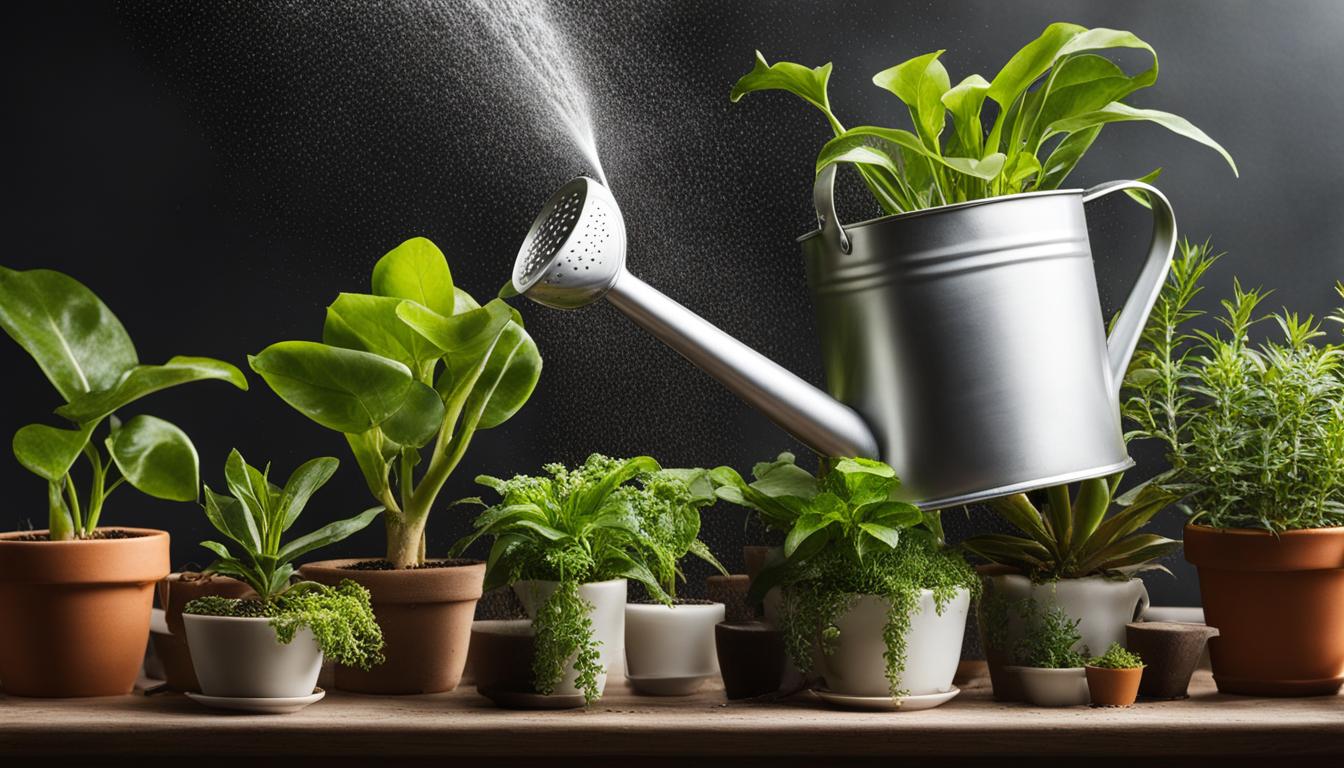
Knowing how to properly water indoor plants is crucial for their overall health and well-being. Using the correct watering techniques and practices can make a significant difference in the growth and vitality of your indoor plants.
In this article, I will guide you through the best watering practices to ensure your indoor plants thrive and flourish.
Key Takeaways:
- Proper watering techniques are essential for the health of indoor plants.
- Using a watering can with a long spout allows for precise watering at the base of the plants.
- Avoid using softened water for indoor plants as it may negatively impact their health.
- Check the soil moisture before watering and avoid following a rigid watering schedule.
- Thoroughly soak the soil during watering, but be careful not to overwater.
Use a Watering Can for Precise Watering
When it comes to watering your indoor plants, using a watering can is a simple yet effective tool for precise watering. The long spout of a watering can allows you to direct the flow of water directly to the base of your plants, ensuring that it reaches the roots effectively.
Unlike using a drinking glass or bottle, which can lead to mess and uneven watering, a watering can provides a controlled and targeted approach. By avoiding splashing water onto the foliage, you reduce the risk of fungal diseases and promote healthier plants.
Using a watering can also allows you to observe the moisture levels of the soil as you water. As you pour the water, you can gauge the absorption rate and adjust accordingly, making sure not to overwater or underwater your plants.
Benefits of Using a Watering Can for Precise Watering
Using a watering can provides several benefits for indoor plant care:
- Precise watering: The long spout enables you to water the base of the plants directly, promoting root health and preventing water wastage.
- Reduced mess: The controlled flow of water prevents splashing, reducing the need for cleanup.
- Observation and adjustment: You can monitor the moisture levels of the soil and adjust the volume of water accordingly for each plant.
- Prevents fungal diseases: By avoiding wetting the foliage, you minimize the chances of fungal diseases taking hold.
Overall, using a watering can for precise watering is a simple yet effective method to ensure the health and vitality of your indoor plants. By providing targeted hydration at the root level, you can promote optimal growth and minimize the risk of overwatering or underwatering.
Avoid Softened Water for Indoor Plants
When it comes to watering your indoor plants, the type of water you use can have a significant impact on their health and well-being. While softened water may be suitable for household use, it is not ideal for watering indoor plants. Softened water is treated with sodium to remove minerals, which can have adverse effects on your houseplants.
The sodium present in softened water can harm the delicate balance of nutrients and minerals that indoor plants require for proper growth.
It can lead to an accumulation of salt in the soil, which can damage the plant’s roots and inhibit their ability to absorb water and nutrients effectively. Over time, this can result in stunted growth, yellowing leaves, and overall decline in plant health.
To ensure the optimal health of your indoor plants, it is best to avoid using softened water for watering. Instead, consider filling up your watering can from an outdoor spigot or using filtered or purified water.
This will help maintain the natural composition of the soil and provide your plants with the essential nutrients they need to thrive.
Comparison of Water Types for Indoor Plants
| Water Type | Advantages | Disadvantages |
|---|---|---|
| Tap Water | Convenient and readily available | May contain chlorine or other chemicals |
| Filtered Water | Removes impurities and chemicals | Requires additional filtration system |
| Purified Water | Free from contaminants and minerals | May lack essential nutrients |
| Rainwater | Naturally soft and chemical-free | Availability dependent on rainfall |
By using the right type of water for your indoor plants, you can ensure their continued growth and vitality. Remember, watering is just one aspect of plant care, and understanding the specific needs of your plants will help them thrive in their indoor environment.
Water Indoor Plants as Needed
Knowing when to water indoor plants is crucial for their overall health and well-being. Each plant has unique water requirements, and understanding how to check soil moisture is essential in determining when it’s time to water. By following these simple guidelines, you can ensure that your indoor plants receive the proper amount of hydration.
Knowing When to Water
- Check the soil moisture by touching the top layer of soil with your finger. If it feels dry to the touch, it’s a clear sign that your plant needs water.
- Pay attention to the weight of the pot. If it feels lightweight when lifted, it’s an indication that the plant is thirsty and requires watering.
- Observe the plant’s foliage. If the leaves appear droopy or wilted, it’s a sign that the plant is dehydrated and needs to be watered.
It’s important to note that different plants have different water needs, so it’s essential to check each plant individually. Factors such as the size of the pot, the type of plant, and environmental conditions can impact how often you need to water.
Proper Watering Techniques
When watering indoor plants, it’s best to use room temperature water to avoid shocking the roots. Make sure to water the plant thoroughly until water starts to drain out of the pot’s drainage holes.
This ensures that the roots receive enough water and helps prevent the risk of root rot. Avoid overwatering by allowing the soil to dry out between waterings.
In addition to checking the soil moisture, it’s important to consider other factors like humidity levels, temperature, and light exposure when determining the watering frequency for your indoor plants.
By understanding the specific needs of each plant and providing them with the proper care, you can help them thrive and flourish in your indoor space.
| Plant Name | Watering Frequency |
|---|---|
| Fern | Weekly |
| Succulent | Every 2-3 weeks |
| Peace Lily | When top inch of soil is dry |
| Spider Plant | When soil feels slightly dry |
Don’t Follow a Watering Schedule
When it comes to watering indoor plants, one common mistake is relying too heavily on a fixed watering schedule. While having a schedule can provide a helpful reminder, it’s important to remember that each plant has different water requirements. Sticking to a rigid calendar can lead to overwatering or underwatering, both of which can harm your plants.
Overwatering occurs when plants receive more water than they need, which can lead to root rot and other problems. Underwatering, on the other hand, can cause wilting, stunted growth, and dry soil. To prevent these issues, it’s essential to tailor your watering practices to the individual needs of each plant.
Instead of relying solely on a schedule, check your indoor plants regularly for signs of moisture. One way to do this is by touching the soil with your finger. If it feels dry, it’s time to water. If it feels moist, hold off on watering for a little longer. By paying attention to the needs of your plants and adjusting your watering accordingly, you can help them thrive.
Soak the Soil Thoroughly
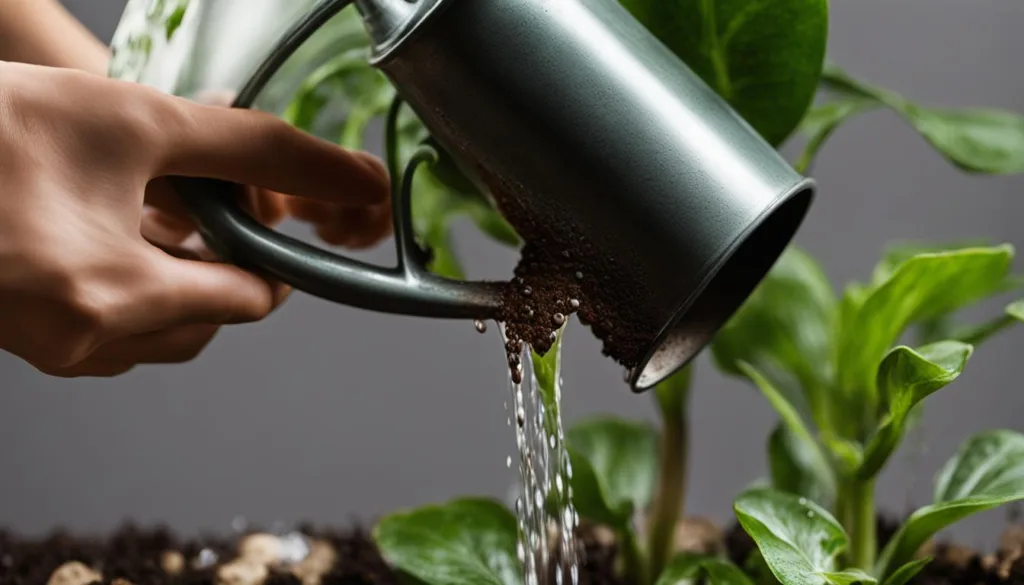
Proper watering is essential for the health and vitality of your indoor plants. One important technique to ensure your plants thrive is to soak the soil thoroughly during watering. By doing so, you encourage healthy root development and ensure that the roots receive enough water to sustain the plant.
To soak the soil thoroughly, water your plants until you see water starting to come out of the pot’s drainage holes.
This indicates that the water has reached the bottom of the pot and that the roots have been adequately hydrated. However, it’s important not to overwater and allow the soil to become excessively saturated, as this can lead to root rot.
By soaking the soil thoroughly, you provide the roots with the moisture they need to grow and absorb nutrients effectively. This technique also helps prevent the accumulation of salts and minerals in the soil, which can be harmful to your plants over time.
Remember to adjust your watering frequency based on the specific needs of each plant, as some may require more frequent watering than others.
Benefits of Soaking the Soil Thoroughly
Soaking the soil thoroughly offers several benefits for the health and growth of your indoor plants:
- Encourages deep root growth: By allowing the water to penetrate deeper into the soil, you promote the development of strong and healthy roots.
- Prevents underwatering: Thoroughly soaking the soil ensures that the roots receive sufficient moisture, reducing the risk of underwatering and the associated negative impacts on plant health.
- Helps flush out accumulated salts: The excess water that drains out of the pot carries away any accumulated salts, preventing their build-up in the soil.
- Enhances nutrient absorption: Well-hydrated roots are better able to absorb essential nutrients from the soil, resulting in healthier and more vibrant plants.
By adopting the practice of soaking the soil thoroughly during watering, you can provide your indoor plants with the optimal conditions for growth and ensure their long-term well-being.
Watering Methods for Indoor Plants
When it comes to watering indoor plants, there are two primary methods to choose from: watering from the top or watering from the bottom. Each method has its own benefits and considerations, so let’s take a closer look at both.
Watering from the Top
Watering from the top is the most common method used for indoor plants. To water from the top, simply use a watering can with a long spout to target the base of the plant, ensuring that the water reaches the roots without wetting the foliage.
This method allows for precise watering and helps prevent the risk of water splashing onto the leaves, which can lead to fungal diseases.
One advantage of watering from the top is that it allows you to visually inspect the plant as you water. This gives you the opportunity to check for any signs of pest infestation, disease, or other issues that may require attention. Additionally, watering from the top can help flush out any built-up salts or mineral deposits in the soil.
Watering from the Bottom
Alternatively, you can choose to water your indoor plants from the bottom. This method involves placing the plant’s pot in a saucer or container filled with water and allowing the plant to absorb the water through the drainage holes in the bottom of the pot.
Bottom watering can be especially beneficial for plants with sensitive or delicate foliage, as it eliminates the risk of water splashing onto the leaves.
Bottom watering promotes healthier root development by encouraging the roots to grow downward in search of water.
This method also helps prevent overwatering, as any excess water will be absorbed back into the saucer, preventing the roots from sitting in stagnant water. However, it’s important to ensure that you don’t leave the plant sitting in water for too long, as this can lead to root rot.
Ultimately, the choice of watering method depends on your personal preference and the needs of your indoor plants. Some plants may prefer one method over the other, so it’s essential to observe how your plants respond to each method and adjust your watering practices accordingly.
Whether you choose to water from the top or bottom, the key is to provide your indoor plants with the right amount of water to keep them healthy and thriving.
Signs of Overwatering and Underwatering
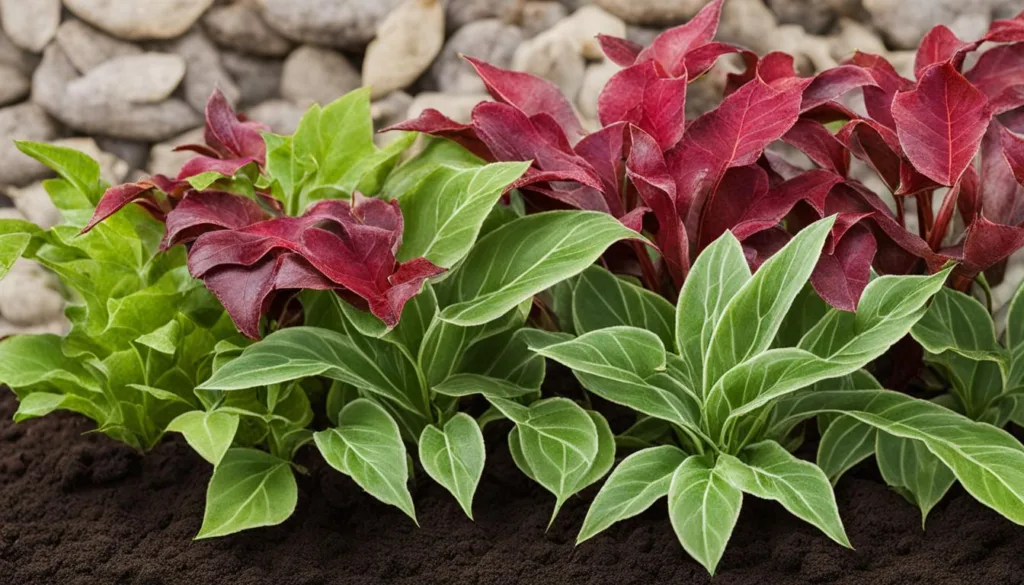
Proper watering is crucial for the health of your indoor plants. However, it can be challenging to determine the right amount of water they need.
Overwatering and underwatering are common mistakes that can negatively impact your plants. By recognizing the signs, you can adjust your watering practices accordingly to ensure the well-being of your indoor plants.
Signs of Overwatering
Overwatering can lead to root rot, yellowing leaves, and wilting. Here are some key signs to look out for:
- Yellow or pale green leaves: When you overwater your plants, the roots become waterlogged, resulting in oxygen deprivation. This causes the leaves to turn yellow or pale green.
- Wilting despite moist soil: Paradoxically, overwatered plants may show wilting symptoms even though the soil is moist. This occurs because the roots are damaged and cannot absorb water properly.
- Root rot: Excessive moisture promotes the growth of fungi and bacteria, leading to root rot. Signs of root rot include foul odor, slimy roots, and blackened or mushy roots.
Signs of Underwatering
Underwatering can deprive your plants of vital moisture, hindering their growth and survival. Keep an eye out for the following signs:
- Wilted or drooping leaves: When plants don’t receive enough water, their leaves will start to wilt or droop as a defense mechanism to conserve moisture.
- Dry soil: Underwatered plants often have dry soil, which can become compacted and hard. Check the soil’s moisture level by inserting your finger about an inch into the soil; if it feels dry at that depth, watering is needed.
- Stunted growth: Insufficient water supply can hinder the growth of your plants, resulting in stunted or slow growth.
By closely observing these signs, you can adjust your watering routine to meet the specific needs of your indoor plants. Remember that each plant is unique, and factors such as humidity, light exposure, and temperature can influence their water requirements. Striking the right balance will help your plants thrive and flourish.
| Signs of Overwatering | Signs of Underwatering |
|---|---|
| Yellow or pale green leaves | Wilted or drooping leaves |
| Wilting despite moist soil | Dry soil |
| Root rot | Stunted growth |
Recognizing the signs of overwatering and underwatering is crucial for maintaining healthy indoor plants. Pay attention to the condition of the leaves, soil moisture, and overall growth of your plants. By adjusting your watering practices accordingly, you can ensure that your indoor plants thrive and bring beauty to your living space.
Watering Variables for Indoor Plants
When it comes to watering indoor plants, there are several variables that can impact their watering needs. Understanding these factors will help you adjust your watering practices accordingly and ensure the health and vitality of your plants.
One significant variable is the potting medium. Different potting mixes have different water retention capacities. Plants potted in well-draining soil will require more frequent watering compared to those in soil that retains moisture for longer. Consider the composition of your potting mix when determining your watering schedule.
Environmental conditions also play a crucial role in indoor plant watering. Factors such as light exposure, temperature, and humidity can affect how quickly the soil dries out. Plants in bright, sunny areas may require more frequent watering, especially during hot summer months.
Likewise, plants in low-light conditions may need less water to avoid overwatering. Monitor the conditions in your home and adjust your watering accordingly.
Other factors to consider include the growth phase of your plants, the type of water used, the timing of watering, and the aeration of the soil. During active growth periods, plants may require more water to support their development.
The type of water you use can also impact your plants, with some tap water containing minerals that can affect their health. Additionally, watering in the morning allows any excess moisture to evaporate throughout the day, reducing the risk of fungal diseases.
Finally, ensuring proper soil aeration through techniques like gentle stirring or using containers with drainage holes promotes healthy root growth.
Watering Variables for Indoor Plants
Consider these variables and adjust your watering practices accordingly to provide the optimal conditions for your indoor plants. By understanding the factors that affect indoor plant watering, you can ensure that your plants thrive and bring beauty and freshness to your home.
After reading this, check out our other articles on:
- What Practices Ensure the Longevity of Indoor Plants?
- What is the Optimal Lighting for Various Indoor Plants?
FAQ
What are the best watering practices for indoor plants?
The best watering practices for indoor plants include using a watering can with a long spout to direct water to the base of the plants, avoiding softened water, checking the soil moisture before watering, and adjusting watering frequency based on the plant’s needs.
Why should I use a watering can for indoor plants?
Using a watering can with a long spout allows you to direct the water flow to the base of the plants, ensuring effective watering and preventing mess and uneven watering that can occur when using a drinking glass or bottle.
Can I use softened water to water my indoor plants?
It is not recommended to use softened water for watering indoor plants. Water softening systems use sodium, which can negatively affect the health of your plants. If you have a water softener, fill up your watering can at an outdoor spigot or use filtered or purified water instead.
How can I tell if my indoor plants need watering?
To determine if your indoor plants need watering, touch the soil with your finger. If the soil is dry, it’s time to water. If the surface is moist, hold off on watering. Every plant is different, so check each one individually.
Should I follow a watering schedule for my indoor plants?
While having a schedule for checking if your indoor plants need water can be helpful, it’s important not to rely solely on a calendar. Each plant has different water requirements, so sticking to a fixed schedule can lead to overwatering or underwatering. Instead, monitor the soil moisture and adjust your watering practices accordingly.
How should I water my indoor plants?
When watering your indoor plants, it’s important to thoroughly soak the soil until water starts to come out of the pot’s drainage holes. This ensures that the roots receive enough water and promotes healthy root development. Avoid soaking the soil excessively to prevent root rot. You can water from the top using a watering can or bottom water by adding water to the pot’s saucer or using a container to soak the plant from the base.
What are the signs of overwatering and underwatering indoor plants?
Signs of overwatering indoor plants include yellowing leaves, wilting, and root rot. Signs of underwatering include wilted leaves, dry soil, and stunted growth. Pay attention to these signs to adjust your watering practices accordingly.
What factors affect the watering needs of indoor plants?
Several variables can affect the watering needs of indoor plants, including the potting medium, light exposure, temperature, humidity, and growth phase. Factors such as the type of water used, timing of watering, and aeration of the soil also play a role. Understanding these variables will help you adjust your watering practices accordingly.

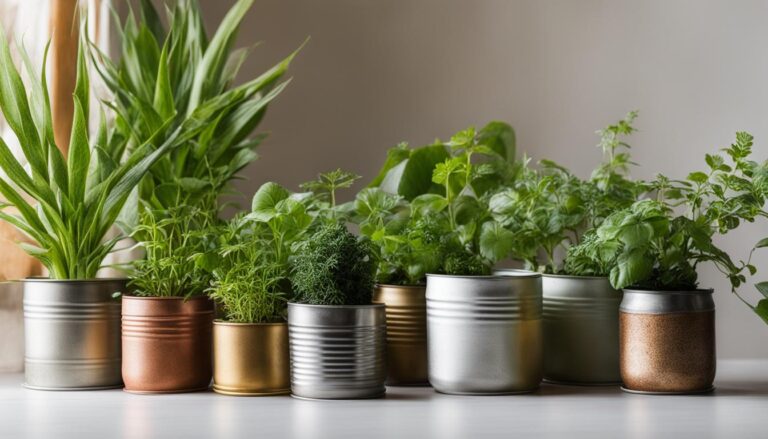
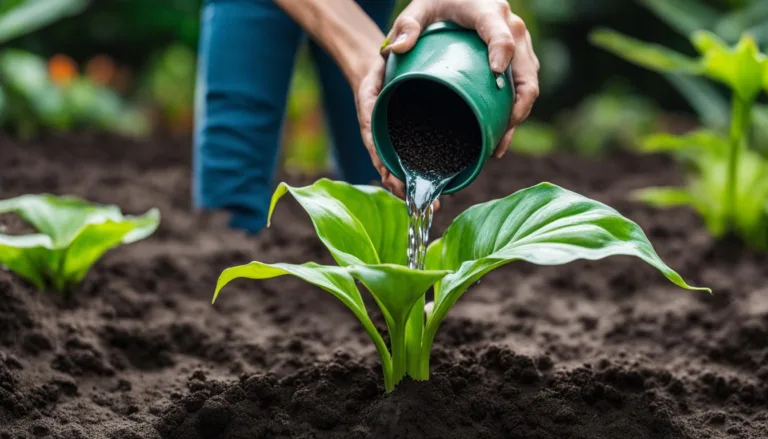

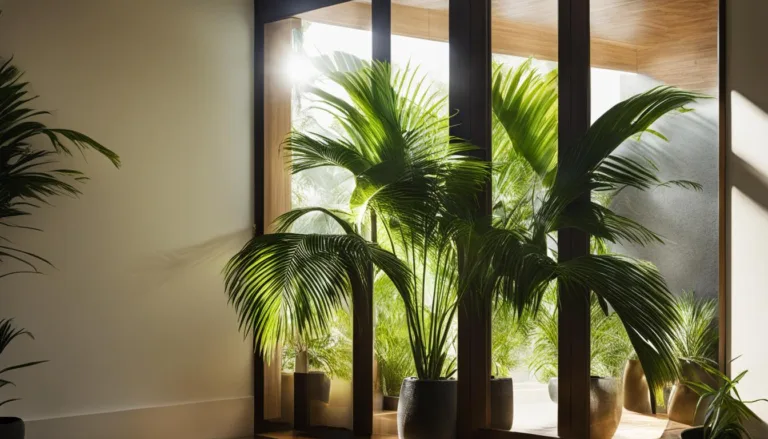
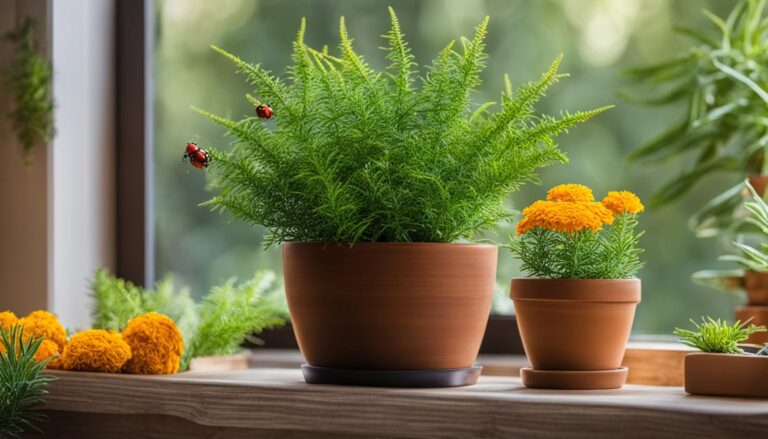
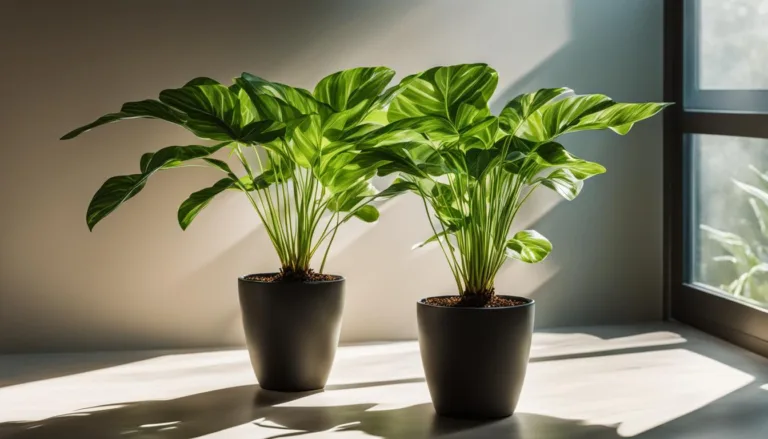
One Comment
Comments are closed.